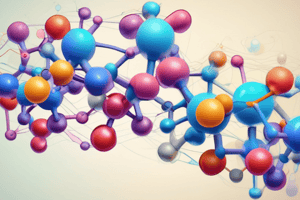Podcast
Questions and Answers
What is the most critical nutrient for the human body?
What is the most critical nutrient for the human body?
Water
What is the pH of pure water?
What is the pH of pure water?
- 7 (correct)
- 9
- 8
- 6
A solution with a pH less than 7 is considered basic.
A solution with a pH less than 7 is considered basic.
False (B)
What is the dissociation constant (Ka) of a strong acid?
What is the dissociation constant (Ka) of a strong acid?
Which of the following is a property of water?
Which of the following is a property of water?
What does the Henderson-Hasselbach equation relate?
What does the Henderson-Hasselbach equation relate?
Acidosis occurs when the blood pH is higher than normal.
Acidosis occurs when the blood pH is higher than normal.
What is the normal pH of human blood?
What is the normal pH of human blood?
What term describes a substance that increases the proton concentration in a solution?
What term describes a substance that increases the proton concentration in a solution?
Which of the following acids is considered a weak acid?
Which of the following acids is considered a weak acid?
What does an increased anion gap indicate in a patient with acidosis?
What does an increased anion gap indicate in a patient with acidosis?
The formula to calculate pH is ______.
The formula to calculate pH is ______.
Match the following terms with their definitions:
Match the following terms with their definitions:
Study Notes
Water
- Critical nutrient, constituting approximately 72% of human body weight; levels vary with age.
- Majority is intracellular fluid, but also found in extracellular fluid and blood plasma.
- Functions include nutrient transport, temperature regulation, waste elimination, and joint lubrication.
Structure and Properties of Water
- Polarity creates positive and negative ends, facilitating its role as an excellent solvent.
- Water interacts with ionic compounds like NaCl, forming hydration shells around ions.
- Dissolves polar organic molecules such as proteins and glucose through interactions with their surface.
- Water molecules are linked by hydrogen bonds, enhancing cohesion and affecting surface tension.
Acids, Bases, and Buffers
- Water dissociates into hydrogen (H+) and hydroxyl (OH-) ions; in pure water, [H+] = [OH-] = 1 x 10⁻⁷ M.
- pH calculation involves the negative log of hydrogen ion concentration (pH = -Log[H+]); pure water has a pH of 7 (neutral).
- Blood pH is approximately 7.4, but can shift due to acidosis or alkalosis.
Acid and Base Overview
- Brönsted-Lowry Definition:
- Acid: Substance that increases [H+] in solution (lowers pH). Example: Ketone bodies in diabetic acidosis.
- Base: Substance that decreases [H+] (raises pH). Example: Bicarbonate in metabolic alkalosis.
Strong vs. Weak Acids
- Strong acids dissociate completely (Ka > 1; pKa < 1), e.g., HCl, H₂SO₄.
- Weak acids dissociate partially (Ka < 1; pKa > 1), e.g., lactic acid, ketone bodies.
- Ka is the dissociation constant; pKa = -Log(Ka).
Henderson-Hasselbach Equation
- Provides a method to calculate pH of solutions involving weak acids and their conjugate bases: pH = pKa + log([A-]/[HA]).
- Example with bicarbonate and carbonic acid; pKa for carbonic acid is 6.1.
Maintaining Blood pH
- Body produces 13 to 22 moles of acid daily via metabolism, primarily carbonic acid.
- Mechanisms for pH regulation include:
- Respiratory system expelling CO₂.
- Kidneys excreting H⁺ and reabsorbing bicarbonate.
- Buffers (e.g., bicarbonate buffer system) resist pH changes.
Primary Acid-Base Disorders
- Acidosis: Blood pH < 7. Normal types include metabolic and respiratory acidosis.
- Alkalosis: Blood pH > 7. Normal types include metabolic and respiratory alkalosis.
Metabolic Acidosis
- Characterized by decreased bicarbonate in blood due to excess acid production.
- Compensatory response includes increased respiratory rate to expire CO₂ and restore pH.
Respiratory Acidosis
- Results from inadequate CO₂ removal, leading to carbonic acid accumulation and lowered pH.
- Renal compensation involves increased excretion of H⁺ and reabsorption of bicarbonate.
Metabolic Alkalosis
- Elevated blood pH caused by excessive loss of acid or increased bicarbonate.
- Compensatory mechanism includes hypoventilation, increasing CO₂ levels.
Respiratory Alkalosis
- Caused by hyperventilation leading to excessive loss of CO₂.
- Compensation mechanisms involve reduced renal excretion of H⁺ and HCO₃⁻ reabsorption.
Anion Gap
- A calculated difference between cations and anions in serum; useful for diagnosing metabolic disorders.
- Normal anion gap values range from 10 to 20 mEq/L when potassium is included.
- High anion gap indicates metabolic acidosis, often linked to conditions like diabetic ketoacidosis and lactic acidosis.
Studying That Suits You
Use AI to generate personalized quizzes and flashcards to suit your learning preferences.
Related Documents
Description
Dive into the fundamentals of water, acids, bases, and buffers as explored in Marks' Basic Medical Biochemistry. This quiz assesses your understanding of these crucial concepts in a clinical context. Prepare to enhance your knowledge in medical biochemistry through targeted questions.




